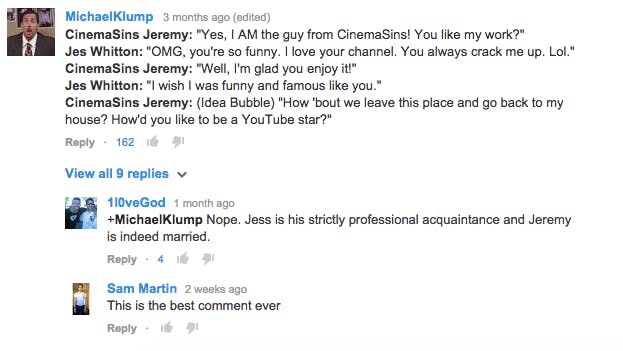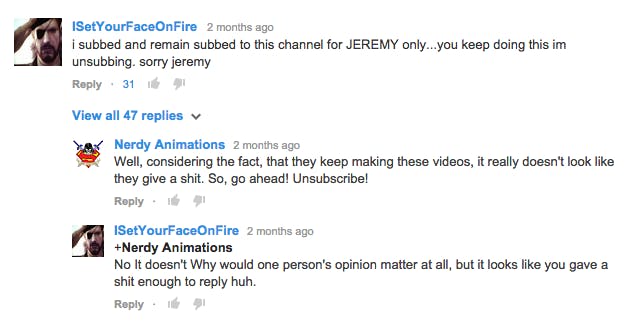As if the Twilight saga or anything by Zack Snyder weren’t bad enough already, YouTube channel Cinema Sins has become a huge success through its succinct takedowns of these and a host of other flawed Hollywood hits. Founded by ex-cinema employees Jeremy Scott and Chris Atkinson, the result of three years is hundreds of videos, millions of hits, and a truly distinctive voice: the well-informed yet bitter amateur filmmaker disillusioned with unimaginative mainstream cinema. It’s a voice that speaks to a wide audience.
So like Ron Howard stepping off the set and into the director’s chair, this prosperous channel with a notable fanbase and idiosyncratic style decided to branch out. What resulted was Brand Sins, How to Make and Music Video Sins, new additions to the already flawless original. The driving force for the expansion was simply “fun and world domination” for the duo.
But soon, a problem occurred: How could co-founder and voiceover artist Jeremy Scott split his time between three simultaneous weekly projects? The answer appeared to be to diversify the ranks; Jess Whitton and Bobby Burns, already established YouTube personalities, became presenters for the new shows. Scott and Atkinson were comfortable giving away a portion of the control, saying “We think our brand naturally extends to other areas, but we won’t always be able to be the voice, the host, or the editor of each new thing.” They gambled that one aspect of Cinema Sins’ success—its strong writing—would be enough to make the new shows a hit, ignoring the importance of Scott’s talent as a unique presenter.
The gamble was a bust. Soon came an avalanche of criticism from fans directed at the new presenters, covering a litany of reasons from subtle pointers on their style to outright rage at their mere existence. Some insinuated that the only way Whitton would be able to gain the role as Brand Sins presenter would be as Scott’s girlfriend; others said that Burns should quit any hopes of a career in entertainment, YouTube or otherwise. The overarching theme? Fans wanted the exact same format and the exact same host as before… just with a few new jokes thrown in.
However, the Sins team leapt to their new presenters’ defense, pleading that fans had not yet warmed to a new style and encouraging commenters to be less hasty. People can be fickle, Cinema Sins knew; they always subtly adapted their show to suit the needs of the viewer, from extending the length of the videos to inquiring about what movie people wanted to see critiqued next. “We rely on them greatly for suggestions, and we watch our statistics closely to learn what our audience enjoys,” the duo said. “But we aren’t going to be persuaded very much by a single video or two with a higher dislike number than usual or more negative comments than usual. Part of that is our natural stubbornness. Part of it is just statistical common sense.”
But did the risky new direction of Brand Sins and How to Make—the only two series with new presenters—go against the Cinema Sins formula? It’s inevitable that the channel was going to expand beyond a point where a lone presenter could handle everything. As a YouTube channel gets more attention, positive or negative, the audience becomes important content influencers; they are integral to the channel’s future and, effectively, some people’s only source of income. We meet an old dilemma here: the compromise between creator’s intention and audience’s desire. Does this creatively constrict the channel, bound by the overwhelming notions of what a multitude of fans want? Or, through giving a multitude a voice, is a more democratic process with an inclusive atmosphere possible?
As Steve Jobs once said, “People don’t know what they want until you show it to them.” This lambasts the notion of giving people everything they want, that it’s better to surprise and tease their whims, potentially met by initial opposition. Sometimes instead of listening directly to the consumer, you have to give them the unexpected, stick to your guns, and know there’s a chance they’ll be receptive to it. Indeed, a few personalities on YouTube are able to rise above the fray, dictating their own content to a receptive audience. PewDiePie, the most popular person on the platform (with more than 34 million subscribers), spans a diverse set of subjects in the knowledge that his loyal fanbase comes directly for him, rather than specific content.
But on other channels, you could be run out of town with burning pitchforks (or at least the online equivalent thereof) for defying expectations. Take online film commentator Doug Walker, or the Nostalgia Critic as he’s better known. Walker, tired of straight video criticism, wanted to make his own film parodies and believed that this passion would be contagious to his fans. The resulting series, Demo Reel, mixed film parodies in a comedy sketch style and was hated by fans. After his experiment failed, Walker went back to recording Nostalgia Critic, reflecting on what the experience brought him: “I learned a lot from the mistakes of that show, especially in terms of marketing and working to please the fans,” he told Huffington Post’s Mat Greenfield. Walker has now compromised: Live-action parody does make up a lot of his new videos, but only with the criticism at the forefront, giving the viewers what they desire.
Success can come more easily when you operate with a more democratic ethos to content creation. Beauty vlogger Alissa Marino agrees, saying: “I get more views for requests because that’s what they request me to film, so they want to see it, so naturally they get more views.” Believing that requested videos are one of the best ways to draw people in, she’s less inclined to experiment: “When I try new things, usually my subscribers aren’t interested because they like seeing familiar videos and tags.” However, no matter what the topic, she says she believes you have to always be comfortable with the videos you produce. “If someone suggests something that is completely out of my reach or that I genuinely do not feel like filming, I’ll ignore it.”
Adam Johnston of Your Movie Sucks has decided that relying on requests wouldn’t work for the type of content he’s producing. He avoids critiquing cult favourite The Room because “I want to be a bit more unique than that. I don’t want to regurgitate everything that everyone has already said. I want to be able to continue providing fresh perspectives.” He did, however, capitulate when it came to last year’s biggest movie, Frozen: “When I hit 100,000 subscribers, I reviewed Frozen as a way of saying ‘thank you’ to my audience. That film was easily the most requested of that year.” Sure enough, the video gained 403,082 views and a new fanbase for Johnston. Both Johnston and Marino realize the importance of listening to the general consensus and trying to satisfy both the creator and the viewer, however tricky that may be.
After getting so badly burned in their debacle, how do the guys from Cinema Sins view the whole debate? When we asked about the backlash, they replied, “People don’t like new things, basically. Our audience, especially, has been groomed (by us) to spot ‘sins’ and to nit-pick and to be grumpy about content. So we get it.
“There is a clear gut-reaction thing on YouTube when popular channels try something new. We were prepared for it and expected it,” they added. “We’re involved in the new channels and series as producers, and give plenty of feedback to those hosting or creating, but our focus in terms of our time remains on the main Cinema Sins channel’s videos.” I asked Bobby Burns, one of the channel’s new presenters, for his thoughts. “People want to be able to sum you up after just a few seconds of seeing you. If you take into account what everyone wants, it does get you down. But at the end of the day you want to just make what you want—that’s what YouTube is all about, really.”
Ultimately, at a time when we have unlimited entertainment options and a finite amount of free time, we often judge things with a knee-jerk opinion to discern what’s the most worthy. But the folks at Cinema Sins aren’t scared. “We’re stubborn. But also, any channel/YouTuber that sticks with only one thing for too long will eventually wither and die out. We have to keep trying new things, both for our online video future and our own creative fulfilment.” Who knows? If we can get past Richie Cunningham and enjoy Apollo 13, there’s always a chance of loving something you’ve taken a risk on.
Screengrab via CinemaSins/YouTube


